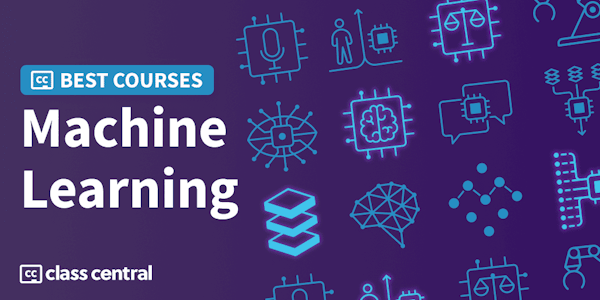Overview
Python is one of the most widely used programming languages in machine learning (ML), and many ML job listings require it as a core skill. This course equips aspiring machine learning practitioners with essential Python skills that help them stand out to employers.
Throughout the course, you’ll dive into core ML concepts and learn about the iterative nature of model development. With Python libraries like Scikit-learn, you’ll gain hands-on experience with tools used for real-world applications. Plus, you’ll build a foundation in statistical methods like linear and logistic regression.
You’ll explore supervised learning techniques with libraries such as Matplotlib and Pandas, as well as classification methods like decision trees, KNN, and SVM, covering key concepts like the bias-variance tradeoff. The course also covers unsupervised learning, including clustering and dimensionality reduction.
With guidance on model evaluation, tuning techniques, and practical projects in Jupyter Notebooks, you’ll gain the Python skills that power your ML journey. ENROLL TODAY to enhance your resume with in-demand expertise!
Syllabus
- Introduction to Machine Learning
- This module provides you with knowledge of foundational machine learning concepts to delve deeper into applied machine learning modeling. You will learn that machine learning modeling is an iterative process with various lifecycle stages. You will also learn about the daily activities in the life of a machine learning engineer. Here, you will be introduced to various open-source tools for machine learning, including the popular Python package scikit-learn.
- Linear and Logistic Regression
- In this module, you will explore two foundational statistical modeling methods, linear regression and logistic regression, which are considered classical machine learning models. Linear regression, often applied in real-world problem-solving, models a linear relationship between independent variables and a dependent variable. Logistic regression, an extension of linear regression, functions as a classifier and can handle nonlinear relationships through input transformation. By implementing these models, you'll gain insight into their limitations and better understand the advancements offered by modern machine learning models.
- Building Supervised Learning Models
- In this module, you’ll learn about implementing modern supervised machine learning models. You will start by understanding how binary classification works and discover how to construct a multiclass classifier from binary classification components. You’ll learn what decision trees are, how they learn, and how to build them. Decision trees, which are used to solve classification problems, have a natural extension called regression trees, which can handle regression problems. You’ll learn about other supervised learning models, such as KNN and SVM. You’ll learn what bias and variance are in model fitting and the tradeoff between bias and variance inherent to all learning models in various degrees. You’ll learn strategies for mitigating this tradeoff and work with models that do a very good job accomplishing that goal.
- Building Unsupervised Learning Models
- In this module, you'll explore unsupervised learning, a machine-learning approach that doesn't require labeled data. Instead of using correct answers, these algorithms identify patterns in data based on similarity. These patterns form clusters in an N-dimensional feature space, where data points that are close together can be considered clusters. Clusters may have a hierarchical structure, similar to natural systems such as galaxies or biological taxonomies. You'll learn about clustering algorithms and how unsupervised learning can reduce features for other modeling tasks, using Python to implement various clustering and dimensionality reduction techniques.
- Evaluating and Validating Machine Learning Models
- In this module, you will learn how to evaluate the performance of supervised machine learning models using various metrics, depending on whether you are building classification or regression models. You will explore hyperparameter tuning techniques like cross-validation to prevent overfitting and ensure an unbiased model evaluation. Additionally, you will learn about regularization techniques for linear regression to mitigate overfitting caused by noise and outliers. Finally, you will gain hands-on experience in building, fine-tuning, and evaluating models using these techniques.
- Final Project and Exam
- This module focuses on applying and demonstrating the skills you have gained throughout the course by completing a comprehensive final assignment. In this assignment, you will analyze historical rainfall data to develop and optimize a classification model. You will perform feature engineering, evaluate the model's performance using different classifiers, and summarize your findings through visualizations. Once completed, your assignment will be graded automatically by an AI grading tool in the next section.
Taught by
SAEED AGHABOZORGI
Tags
Reviews
4.2 rating, based on 4 Class Central reviews
4.7 rating at Coursera based on 16829 ratings
Showing Class Central Sort
-
I really liked this one. One of the best IBM data science courses available. It introduces broad list of subjects and provides some simple code to help you start building your own solutions. Recommend!
-
The ML course in Python offers a comprehensive introduction to machine learning, covering essential topics such as data preprocessing, model selection, and evaluation metrics. With hands-on coding exercises and real-world projects, it effectively bridges the gap between theory and practice. The course structure is well-organized, progressively building on concepts to enhance understanding. The instructors provide clear explanations and are responsive to questions, ensuring a supportive learning environment. Overall, it's an excellent resource for anyone looking to gain practical skills in machine learning using Python.
-
Amazing course. Well organised. Need to add more things.
I have not got certificate. But let's see, when I can get certificate. -
Instructor is clear and know what he is doing. course videos covers basic info and techniques of machine learning, further instructions are taught in lab assignments.








